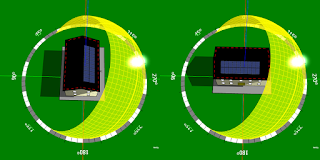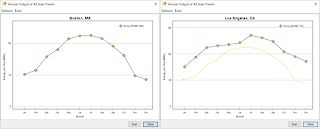 |
| Figure 1: Google Map |
If you are thinking about putting solar panels on your roof, the conventional wisdom is that your house probably would be automatically disqualified if its roof does not have a large south-facing side for installing solar panels. If you have no idea about this, the sales representatives from solar companies would probably tell you this based on their training.
While it might be a smart strategy to target houses with most promising returns at the beginning of the solar energy industry back a decade ago, the old rules may not hold any longer. With the solar cell efficiency of commercial panels climbing above 20% and, more importantly, the environmental awareness of homeowners increasing, the solar energy market has changed a lot.
Thanks to Google Map, it is just a few mouse clicks away to get an idea about the current status of the market. So I surveyed my neighborhoods in eastern Massachusetts and was surprised to find that a significant amount of rooftop solar panel arrays do not actually face south (Figure 1). This is understandable because a significant percentage of buildings do not have a roof that has a south-facing side. So if homeowners living in those houses want to contribute to solving the environmental problems, they do not have any other choice except putting solar panels wherever they can be mounted. If you take a look at your own neighborhood in Google Map, you should spot a lot of west- and east-facing (or even north-facing!) solar panels.
 |
| Figure 2. Solar simulation in Energy3D |
 |
| Figure 3: South-facing vs. west-facing |
I have heard some solar installers accusing competitors of coaxing homeowners into this kind of less effective configurations in order to increase their profits at the expense of the homeowners’ running cost. Before we start pointing fingers at one another, let’s stop and think: Is it really such a horrible idea to put solar panels on a non-south-facing side? The problem is that few people really have an idea about how much less energy those non-ideal configurations would entail compared with the optimal south-facing situation. An estimate of this is critically important to helping homeowners make up their mind whether to go solar or not. And, by the way, it also demonstrates your business ethics and technical capability as well. Unfortunately, in reality, you cannot re-orient people’s houses or roofs to figure that out.
Thanks to the funding from the National Science Foundation, this kind of estimation can be easily done using our Energy3D software, which has a decent crystal ball when it comes to solar modeling and prediction (Figure 2). I have been blogging about this capacity of the software for a while. It is time to finally put this tool into practice to help people evaluate their solar options.
Let’s start with a very simple house and a 5kW solar panel system (Figure 3). The first step is to get a sense of how accurate Energy3D’s prediction may be. In situations similar to the standard test conditions (STC), this system — when oriented to the south — should generate about 6,000 kWh per year in Boston, Massachusetts and about 8,000 kWh per year in Los Angeles, California. The results from Energy3D agree exactly with these widely-cited numbers, as shown in Figure 4.
 |
| Figure 4: BOS vs. LAX |
With this validity, we can then ask the following question: What if we have only a west-facing roof? This can be easily done by rotating the model house in Energy3D 90° and then redo the calculation. It turns out that the homeowner in Boston will get about 80% of the maximal output (when the panels face south), as illustrated in Figure 5. The folks in LA will fare slightly better — about 82%.
 |
| Figure 5: South-facing vs. west-facing outputs |
I believe a large number of homeowners, if informed by the results of this simulation-based analysis, may consider 20% performance reduction as acceptable. Yes, their panels will generate less electricity than those on the roofs of houses with the optimal orientation, but many would like to do whatever they can to help reduce carbon emission. To them, doing it at a pace that is 20% slower is infinitely better than doing nothing at all, letting alone that many houses do not face exactly west and the actual performance reduction will be less than 20%.
The results of this study should give you a sense about how simulations may be useful in fostering the growth of the solar energy market. Even better, through years of development, we have made solar simulation in Energy3D so easy that anyone can do it. As an experimental step, we are now collaborating with high schools in Massachusetts to pilot-test the feasibility of engaging students to evaluate the solarization potential of their own houses. Our goal is to create an integrated education-business model that benefits both sides. We hope that the success of this project will help the world reach the goals set by the Paris Agreement.
One thought on “Making sense of non-optimal solar panel orientations seen on Google Maps”
Comments are closed.
An installer in California once told me that west-facing was almost as good as south because 1. Energy is more valuable in the evening, 2. Their city is cloudier in the morning!